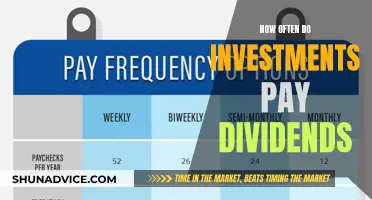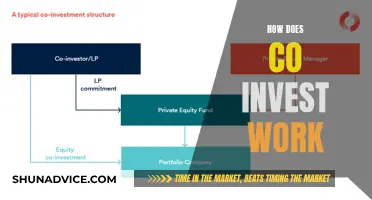
Choosing the right investment can seem daunting, especially if you're new to investing. Before investing, it's important to get your immediate finances in order, pay off any short-term debt, and build an emergency fund.
There are many different types of investments, each carrying different levels of risk and reward. These include stocks, bonds, mutual funds, exchange-traded funds (ETFs), real estate, commodities, and more.
When deciding what to invest in, it's essential to consider your financial goals, risk tolerance, time horizon, knowledge of investing, and how much you can invest.
- Risk and return: Generally, higher-risk investments offer the potential for higher returns, while lower-risk investments provide more stability but lower returns.
- Time horizon: If you're investing for the long term, you may be able to withstand more risk and focus on investments with higher potential returns. For shorter-term goals, consider lower-risk options like savings accounts or certificates of deposit (CDs).
- Diversification: Diversifying your investments across different asset classes, such as stocks, bonds, and real estate, can help manage risk and potentially increase returns.
- Fees and charges: Be mindful of the fees and charges associated with different investment options, as these can impact your overall returns.
- Regulation and protection: Ensure that any investment company you consider is regulated and authorised to sell the product they are offering.
| Characteristics | Values |
|---|---|
| Risk tolerance | Low, medium, or high |
| Time horizon | Short-term or long-term |
| Knowledge of investing | Basic or advanced |
| Financial situation | Manageable debt levels, adequate emergency fund, etc. |
| Amount to invest | Small or large amounts |
What You'll Learn

Evaluate your risk tolerance
When it comes to investing, risk and reward go hand in hand. All investments involve some degree of risk, and risk tolerance is the degree of risk that an investor is willing to take on. It is important to understand your risk tolerance before investing, as it can help you create a portfolio that feels right for you.
There are three types of risk tolerance: aggressive, moderate, and conservative. An aggressive investor has a high-risk tolerance and is willing to risk losing money to get potentially better results. They tend to be market-savvy, understand the volatility of securities, and follow strategies for achieving higher-than-average returns. Their investments emphasize capital appreciation rather than income preservation. This investor's asset allocation commonly includes stocks and little to no allocation to bonds or cash.
A moderate investor wants to grow their money without losing too much. Their goal is to weigh opportunities and risks, and their approach is sometimes described as a "balanced" strategy. They commonly develop a portfolio that includes a mixture of stocks and bonds, perhaps as a 50/50 or 60/40 structure.
A conservative investor has a low-risk tolerance and favours investments that maintain their original investment. They are willing to accept little to no volatility in their investment portfolios and seek investments with guaranteed returns. Conservative investors often include retirees or those close to retirement age, as they may be unwilling to risk losing their principal investment and have a short-term investment strategy. They typically invest in low-risk assets such as bank certificates of deposit (CDs), money markets, or U.S. Treasuries for income and preservation of capital.
To evaluate your risk tolerance, you can ask yourself several questions:
- How do you feel about risk? This is related to your personality and how you navigate uncertainty. Are you comfortable with the potential for losses, or do you prefer a smoother ride with lower risk?
- What are your investment goals? Are you investing for retirement, saving for a child's education, or something else? Understanding your goals can help you assess your timeframe and estimate how much money you need.
- What is your time horizon? Generally, the longer the time horizon, such as saving for retirement, the more risk you can take. A shorter time horizon, such as saving for a house down payment, means your investments have less time to recover from potential losses.
- How comfortable are you with short-term losses? Investments can fluctuate, and it's important to remember that with stocks, your shares may decline in value, but you don't realize the loss until you sell. If you need your money in the near term, you may have to sell at a loss.
- Do you have non-invested savings? It's important to have some savings set aside in liquid accounts for emergencies, regardless of your risk tolerance. If you're keeping a large portion of your savings in cash because you're nervous about investing, this may indicate that you're risk-averse.
- How often will you track your investments? If you plan to track them frequently, is it because you're nervous or excited about new opportunities? If every down day in the market makes you anxious, a diversified portfolio and a focus on long-term goals can help.
By answering these questions, you can gain a better understanding of your risk tolerance and make more informed investment decisions.
Fear of Investing: Why the Hesitation?
You may want to see also

Consider your investment timeline
When considering what investment is right for you, it is important to evaluate your investment timeline. This will help you decide what type of investment vehicle to consider, which investments to avoid, and how long to hold your investment.
Short-term goals
If your goal is less than five years away, a less risky approach is generally recommended to protect you from significant short-term losses. Money market funds, savings accounts, and short-term certificates of deposit are popular conservative investments for short-term goals.
Intermediate-term goals
For goals that are five to ten years away, some exposure to stocks and bonds can help grow your initial investment. Balanced mutual funds, which include a mix of stocks and bonds, are popular investments for intermediate-term goals.
Long-term goals
If your goal is more than ten years away, you may want to consider investments with greater potential rewards, such as stocks. While these entail greater risk, there is often sufficient time to recover from market fluctuations.
Volatility and risk
It is important to note that volatility is often a greater risk in the short term than in the long term. If you have a longer time horizon, you can ride out frequent market moves and give your portfolio time to recover from any losses.
Additionally, the probability of positive returns increases the longer you hold your investments. There is no guarantee of this, but the shorter the period, the greater the chance of suffering losses.
Time horizon and age
Your investment timeline is influenced not only by your goals but also by your age and current regulations. For example, the SECURE 2.0 Act of 2022 defined the age for required minimum distributions (RMDs) from a retirement account as 73, increasing to 75 in 2033.
Adjusting your strategy over time
As your investment timeline progresses, you may need to adjust your strategy. For example, as you get closer to your goal, you may want to shift your assets to more conservative investments to reduce the risk of market fluctuations.
In summary, considering your investment timeline is crucial when deciding what type of investments are right for you. It helps you balance risk and potential returns while ensuring that your investments align with your short-term, intermediate-term, and long-term goals.
Utilities: Invest or Avoid?
You may want to see also

Understand the fees involved
Understanding the fees involved in investing is crucial, as they can significantly impact your overall returns. Here's a detailed guide to help you navigate and understand the various fees associated with investing:
Understanding Investment Fees:
Fees are an inevitable part of investing, and they can take various forms. It's essential to recognize that fees are charged for using financial products, such as broker fees, trading fees, and expense ratios. Over time, minimizing these fees can lead to maximizing your investment performance. However, it's important not to let fees dominate your investment decision-making process. Here are some common types of investment fees:
- Brokerage Fees: These fees are charged by brokerage firms for providing their platform and services. They can vary depending on the firm and the specific services utilized.
- Trading Fees: Trading fees, also known as commission fees, are incurred when you buy or sell an investment. The amount may depend on the asset being traded and the number of trades executed.
- Expense Ratios: This is the fee associated with managing a mutual fund or ETF. It is expressed as a percentage of the average net assets and includes management fees, distribution fees, and other expenses.
- Sales Charge (Load) Fees: These fees are similar to commission fees and are charged when buying (front-end load) or selling (back-end load) shares in a mutual fund.
- Management or Advisory Fees: When you hire an investment advisor or financial institution to manage your investment account, you will be charged a management or advisory fee, typically a percentage of your portfolio value.
The Impact of Fees:
Investment fees can have a significant impact on your overall returns. Even small percentages or fractions of a percentage can translate to thousands of dollars over time. For example, according to the SEC, a 0.50% annual fee on a $100,000 investment can reduce its value by $10,000 over 20 years. A higher annual fee of 1% can reduce the same investment by up to $30,000.
Minimizing Investment Costs:
While investing inevitably involves costs, there are strategies to minimize these expenses:
- Buy-and-Hold Strategy: Reducing the frequency of buying and selling investments can lower the accumulation of trading fees. A buy-and-hold strategy also tends to yield better returns than frequent trading.
- Tax-Deferred or Tax-Exempt Accounts: Consider utilizing tax-deferred accounts, such as 401(k)s or traditional IRAs, which allow investments to grow tax-free until withdrawal. Roth IRAs are another option, where earnings and withdrawals after a certain age are tax-free.
- No-Fee Brokers: Opting for no-fee online brokers and no-load mutual funds can help reduce transaction costs.
- Low-Cost Index Funds: Choosing low-cost index funds with low expense ratios can provide a cost-effective alternative to actively managed funds.
- Robo-Advisors: Utilizing robo-advisor platforms, which use algorithms to provide automated investing advice, can be a more affordable option compared to human investment advisors.
Final Thoughts:
Understanding the fees involved in investing is crucial for making informed decisions. While fees are a necessary part of the investment process, they should not be overlooked or ignored. By recognizing the different types of fees, their potential impact on returns, and strategies to minimize costs, you can make more effective choices that align with your financial goals. Remember to always review your investment statements to stay informed about the fees you are paying.
Doge Investors: Why the Hype?
You may want to see also

Research the company and its prospects
Researching the company and its prospects is a crucial step in deciding whether an investment is right for you. Here are some key areas to focus on:
Understand the Business:
Get a clear understanding of the company's business model, products, and services. What do they offer, and who are their competitors? This knowledge will help you analyse the company's position in the industry and its potential for growth.
Review Financial Statements:
Analyse the company's financial health by reviewing financial statements, such as annual reports. Look for key figures like revenue, expenses, net income, and cash flow. This will help you gauge the company's financial stability and potential for profitability.
Assess Profitability and Growth:
Evaluate the company's historical financial performance, including revenue and net income growth over the years. Compare their performance with their competitors and industry trends. A company with consistent profitability and growth potential may indicate a strong investment opportunity.
Analyse Competitive Advantage:
Consider what sets the company apart. Do they have a strong brand, patented technology, or a large customer base? A sustainable competitive advantage can contribute to long-term success and growth.
Evaluate Management:
Assess the management team's track record and vision for the company. Look for experienced executives with a history of success in the industry. Ensure their actions align with shareholders' interests.
Study Industry Trends:
Stay updated on industry trends and factors that could impact the company's performance. Changes in technology, regulations, or consumer preferences can affect the company's prospects. Understanding these trends will help you assess the risks and opportunities associated with your investment.
Environmental, Social, and Governance (ESG) Factors:
Consider the company's environmental policies, social responsibility initiatives, and ethical practices. These factors are increasingly important for investors who want to support sustainable and responsible businesses.
Business Segments and Competitors:
Understand the company's major business segments and competitors. Research similar businesses to identify trends and potential risks. Stay informed about industry events and news that may impact the company.
Company History and Location:
Know the company's history, including its financial health and growth prospects. Also, consider where the company is based, as this may impact its operations and future prospects.
Evaluate the Business Model:
Understand how the company intends to grow its revenue and profit margins over time. Review annual reports, SEC filings, and other documentation to assess their financial health and cash flow.
Research Management and Leadership:
Learn about the company's management team and leadership. Are they qualified, experienced, and ethical? Do they have a good track record? You can find this information through press releases, online research, or by talking to people familiar with the company.
By thoroughly researching the company and its prospects, you can make a more informed decision about whether an investment is right for you. Remember to consider your financial goals, risk tolerance, and investment horizon as well.
Real Estate: Why the Hesitation?
You may want to see also

Diversify your portfolio
Diversifying your portfolio is a crucial step in reducing risk and enhancing the overall performance of your investments. Here are some detailed tips to help you diversify your portfolio effectively:
Spread Your Investments
The core principle of diversification is to spread your investments across a wide range of assets, industries, and markets. Avoid putting all your eggs in one basket. This strategy helps to balance risk and reward. While stocks offer higher growth potential over the long term, they also carry greater risk. On the other hand, bonds are generally considered less volatile and can provide a cushion against stock market fluctuations.
Explore Different Asset Classes
Invest in a mix of stocks, bonds, commodities, exchange-traded funds (ETFs), and real estate investment trusts (REITs). Diversifying across asset classes can provide both higher potential returns and greater risk management.
Diversify Geographically
Consider investing in international stocks and markets. By investing in non-US companies, you gain exposure to different economic conditions and performance, which can help further diversify your portfolio.
Consider Index or Bond Funds
Index funds offer an easy way to diversify, as they replicate specific indexes and provide instant diversification. They tend to have low fees, but keep in mind they are passively managed, which may be suboptimal in inefficient markets. Bond funds, on the other hand, can add fixed-income solutions to your portfolio, further hedging against market volatility and uncertainty.
Regularly Review and Adjust Your Portfolio
Continuously monitor your investments and stay updated on market conditions. This will help you identify when it's time to cut losses and move on to new investment opportunities. Additionally, regularly adding to your investments through strategies like dollar-cost averaging can smooth out market volatility and reduce investment risk.
Be Mindful of Fees and Charges
When investing in funds, be aware of the fees and charges involved. Upfront fees are common when buying shares through a platform or broker, and there may also be transaction fees when selling. Ongoing charges, such as management fees, are also important to consider. Compare fees across different providers to ensure you're getting good value.
By following these tips, you can effectively diversify your portfolio, reducing risk and improving your overall investment strategy.
Litecoin: Worth Your Investment?
You may want to see also
Frequently asked questions
Some common types of investments include stocks, bonds, real estate, exchange-traded funds (ETFs), mutual funds, annuities, cryptocurrencies, commodities, collectibles, and precious metals.
Before investing, it's important to get your immediate finances in order. This includes paying off any short-term debt, building an emergency fund, and investing more through your workplace pension.
Generally, the more risk you take, the higher the potential reward but also the higher the potential for losses. It's important to assess your risk tolerance and choose investments that match it.
Different investments offer different potential returns. For example, stocks generally offer larger potential returns than lower-risk investments like government bonds. It's important to understand what you are investing in and how this affects your potential gains or losses.
There are various fees and charges associated with investing, such as upfront fees, transaction fees, and ongoing management fees. These fees can eat into your investment returns over time, so it's important to understand and compare the fees charged by different providers.







